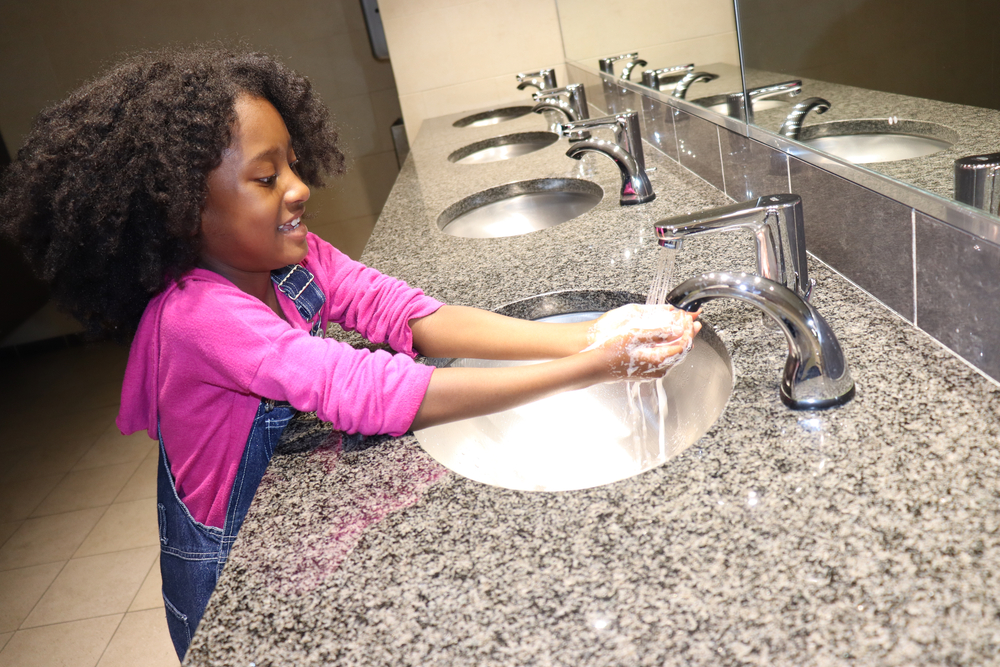What we touch throughout our daily routines carries more risk than most people realize. From morning commutes to evening shopping trips, our hands come into contact with countless surfaces harboring potentially harmful bacteria and viruses. Public health experts continue to identify surprising hotspots for germ transmission in our everyday environments.
The public restroom predicament
Public restrooms present perhaps the most obvious yet unavoidable challenge in our daily lives. Beyond the obvious areas of concern, door handles and faucet knobs harbor an alarming array of pathogens. These surfaces see hundreds, sometimes thousands, of hands daily, many belonging to people who haven’t properly washed their hands. Public health researchers have found these surfaces can harbor everything from E. coli to norovirus, capable of surviving for hours or even days.
The commuter’s conundrum
Public transportation, while essential for millions, creates perfect conditions for germ transmission. The poles and handrails that keep us steady during our journeys collect bacteria and viruses from countless hands throughout the day. Even with regular cleaning protocols, these surfaces become recontaminated within hours. The combination of high touch frequency and diverse user population makes these surfaces particularly concerning for public health experts.
Digital dangers
Our increasing reliance on touchscreen technology has created new pathways for germ transmission. ATMs and self-service kiosks, while convenient, rarely receive proper sanitization between users. These screens accumulate oils from fingertips, creating an ideal environment for bacteria and viruses to thrive. The constant stream of users means these surfaces never truly have time to become germ-free.
The shopping cart scenario
Shopping carts represent an often-overlooked danger in our daily routines. These carts travel throughout stores, touched by countless hands and exposed to various environmental conditions. Research has shown cart handles harbor more bacteria than many public bathroom surfaces. The presence of young children in cart seats adds another layer of contamination risk, as these areas rarely receive thorough cleaning.
Escalator exposure
Escalator handrails, while designed for safety, paradoxically pose health risks. The continuous movement of these rails creates friction and warmth, ideal conditions for bacterial growth. The rubber material commonly used in handrails can trap moisture and organic matter, creating perfect breeding grounds for various pathogens.
The workplace worry
Office environments present their own set of challenges. Shared equipment like copiers, coffee makers, and water coolers become gathering points for germs. The frequency of use combined with inconsistent cleaning practices makes these areas particularly concerning for disease transmission.
Restaurant risks
Dining out introduces several high-risk touch points. Menu cards, condiment containers, and table surfaces often receive only cursory cleaning between customers. These items pass through numerous hands daily, potentially spreading illness-causing organisms among diners.
Gas station germs
Fuel pump handles and keypads represent another frequently overlooked danger zone. These surfaces endure constant exposure to the elements while being touched by hundreds of people daily. Studies have found these surfaces harbor a concerning variety of bacteria and viruses.
Gym equipment exposure
Exercise facilities, despite promoting health, can become hotbeds for germ transmission. Shared equipment, particularly free weights and cardio machine handles, accumulate sweat and bacteria from multiple users throughout the day.
Protection strategies
Modern life requires touching these surfaces, but several strategies can minimize risk. Regular hand sanitization proves crucial, but timing matters more than frequency. Using sanitizer immediately after exposure to high-risk surfaces provides the most effective protection.
The science of surface transmission
Understanding how germs spread through surface contact helps explain why certain areas pose greater risks. Bacteria and viruses can survive on surfaces for varying periods, from hours to days, depending on environmental conditions and the specific pathogen involved.
Environmental factors
Temperature, humidity, and surface material all influence how long germs survive on surfaces. Smooth, nonporous surfaces typically harbor fewer germs than rough, porous materials, but they can also allow pathogens to survive longer under the right conditions.
Seasonal considerations
Risk levels fluctuate throughout the year. Cold and flu season brings increased danger, as more people carry and spread these viruses. Understanding these seasonal patterns helps inform when to take extra precautions.
Building better habits
Creating effective protection routines requires understanding our own behavior patterns. Simple changes, like using knuckles instead of fingertips for touchscreens or carrying personal styluses, can significantly reduce exposure risk.
The role of proper handwashing
While hand sanitizer offers convenience, proper handwashing remains the gold standard for germ prevention. The mechanical action of washing, combined with soap’s chemical properties, provides superior germ removal compared to sanitizer alone.
Technology solutions
Modern innovations offer some relief from these concerns. Touchless payment systems, automatic doors, and motion-activated fixtures reduce the need for direct contact with high-risk surfaces. However, these solutions aren’t always available, making personal protection strategies essential.
The future of public health
As our understanding of disease transmission grows, design changes may help reduce these risks. Antimicrobial surfaces, improved ventilation systems, and more touchless interfaces could create safer public spaces in the future.
Remember, while these surfaces pose risks, practical precautions can significantly reduce the danger of infection. Awareness combined with proper hygiene practices allows us to navigate public spaces more safely while maintaining our daily routines.














